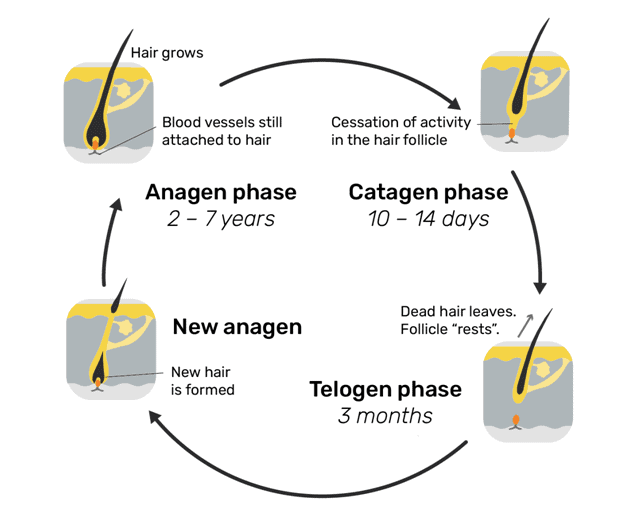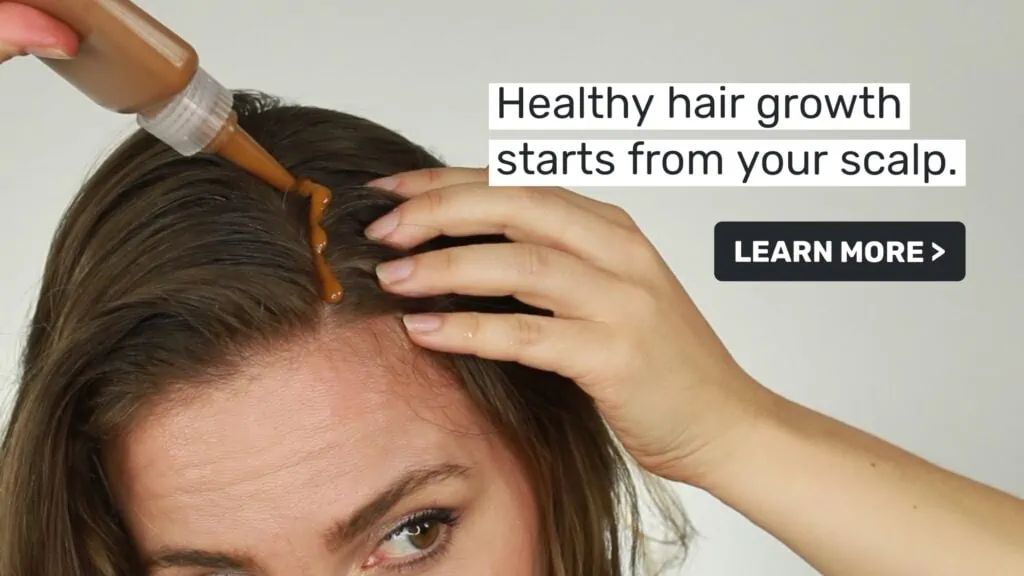Patients who have suffered prolonged and heavy onset of COVID after about 1-3 months experience severe hair loss. The main hypothesis that links COVID and hair loss connects high levels of stress associated with contracting the virus. Especially back in 2020 when little was known about the disease and on top of an already stressful circumstance – people were hospitalised with a new, unknown virus. However, post-COVID hair loss occurs twice as fast than usual stress-related hair loss (known as telogen effluvium): an average of 56 days or 8 weeks after COVID vs 90 days or 3 months, in the standard case of stress-related hair loss. Furthermore, a proportion of people who suffer from post COVID hair loss, report that their hair never grew back to the same density as it was before.
In this article we examine the reasons behind the fast onset of post COVID hair loss, why your hair may not go back to its previous state and what to do about it all if you’re facing post COVID hair loss.
Three phases of hair growth
Before we dive into the specifics of COVID impact on your hair, here is a reminder how your hair cycle usually operates. Through your lifetime, hair follicles go through three main stages multiple times:
- anagen – growth stage (2-7 years)
- catagen – transition stage (10-14 days) and
- telogen – resting stage (3-6 months)
Usually 85-90% of our hair follicles are in the growth stage, 1% in transition and the remaining 9-14% are resting in the telogen stage.

Stress during COVID and hair loss
In periods of extreme stress, your body focuses on maintaining vital functions and organs to keep you alive: your heart and cardiovascular system, lungs and respiratory system, liver and kidneys. In a life-threatening situation, even our digestive tract might get ignored. So, hair growth is by far not the priority function for your body to upkeep. In this case, a case of acute hair loss in COVID from a number of stress-related factors:
- Physical stressors can be as mild as a high fever or having to be placed on a ventilator due to moderate to severe respiratory complications.
- The toll of dealing with COVID can impact how you think and feel, compounding the effect from physical stress and lack of rest and recovery would contribute to mental stressors.
- Stress can alter cells at the base of hair follicles and inhibit proliferation of keratinocytes (cells that make up hair) needed for hair growth. That would stop keratinocytes effectively manufacture your hair – thus causing visible hair loss and bald patches across your scalp. Even if you might not feel stressed as a result of contracting COVID, your body still feels this stress on a physical level – whether as a result of having high fever, fatigue or heavy cough.
- These changes can produce excess cortisol (stress hormones) that place hair follicle stem cells into an extended resting phase leading to acute telogen effluvium in COVID – which means that hair follicle wouldn’t grow hair in that time. (The resting phase – telogen – is where “telogen effluvium” borrows its name.)
It’s worth noting that telogen effluvium is not limited to COVID. It can occur for many reasons, including other viral infections, after a surgery, hospitalization, but also hormonal changes, and, most commonly – stress that is linked to stressful situations such as breakups (yes!), loss of a job or a loved one, relocation, moving house – to name a few. In fact, it is the stress associated with all these is the primary reason why your hair follicles decide to go to sleep all at once. COVID is a viral infection that can lead to stress, which explains why hair loss may occur in some people who suffered COVID.
This however, doesn’t fully explain the accelerated speed at which post-COVID hair loss occurs in comparison to usual stress-related hair loss (3-6 months vs 4-6 weeks in COVID), so let’s examine it further.
Immune system response in COVID impacts hair growth
When you contract COVID, depending on the strength of your immune system your body might experience a cytokine storm – a severe immune reaction in which the body releases too many cytokines into the blood too quickly. Cytokine are proteins that signal your body to manufacture immune cells to help fight the disease. This process causes inflammation in your body tissues – including lining of your organs, your skin and – scalp.
Not only such inflammatory response causes your body to focus on fighting the disease and get all the nutrients from where it can get them, including your hair follicles, but actually, this inflammatory response triggers production of androgens, male sex hormones, which target inflammation – in both, men and women. Androgens, namely DHT (dihydrotestosterone) are excellent at fighting inflammation, but they can trigger androgenic alopecia, especially in patients who already had a predisposition to it (e.g. polycystic ovary syndrome / PCOS in women, menopause in women or male pattern balding in men).
In males, androgenic hair thinning starts at the crown of the head and vertex with pronounced areas of baldness. In women, the hair loss is diffused and evenly spread around the top part of your scalp. In this case, anagen (growth) stage shortens, and telogen (resting) stage – extends which means that your hair is growing for less amount of time and falls out sooner.

Androgenic alopecia and COVID
Androgenic alopecia (AGA) occurs as a result of your body sending DHT (dihydrotestosterone) molecules to fight inflammation in scalp. DHT does an excellent job in that, however it also – (1) causes follicle calcification and scarring to prevent it from future inflammations, and (2) destroys the subcutaneous fat from underneath the epidermis – top layer of the skin, on which the hair follicle rests. These two processes make the growth of new hair more difficult, since hair follicle is smaller due to calcification and scarring around it, and it can’t easily reach the blood vessels that would feed it nutrients because the cushioning of fat is gone to facilitate this process.
Male vs female hair loss after COVID
Since the pandemic began, a number of studies pointed to a close link between AGA and COVID. Amongst the arguments to support this thought, is the severity of COVID being higher in males, and men naturally have higher androgens than women.
However women aren’t safer from hair loss from COVID. Since women possess an extra X chromosome in their genes, which is responsible for immune modulation (response of the body to a disease). This extra chromose makes women more susceptible to the autoimmune disease than men: for example thyroid disease is 8 times more frequent in women than men. As such, women might observe more immune cells being produced in their body as a result of COVID which causes stress-related hair loss as well as inflammation that can trigger AGA.
The triggering of AGA as a result of COVID is the reason why your hair might not grow back to the way it was before. There are ways to tackle and address the symptoms of AGA, and they are primarily rooted in anti-inflammatory diet, regular exercise, scalp blood flow stimulation including scalp massages.
We explained why your hair might not grow back as thick as before, but still didn’t explain the accelerated speed of hair loss… so why do you lose hair so fast after contracting COVID, where some people report as short as 2 weeks after contracting the disease?

Why do you lose hair after COVID so fast?
When we investigate reasons behind sudden hair loss with our customers, they often forget a recent onset of COVID. They start finding handfuls of hair around their house, and even their usual hair growth treatments don’t seem to help. After a few probing questions, more often than not they remember that they had COVID about 1-2 months ago. So why does COVID hair loss happens so much quicker than usual telogen effluvium which can take 3-6 months? The answer lies in blood flow and receptors responsible for regulating blood pressure.
Blood pressure, hair growth and COVID
COVID binds to receptors of angiotensin converting enzyme 2 (ACE2) receptors. Angiotensin is a peptide hormone that causes vasoconstriction (shrinkage of the blood vessels) which can result in an increase in blood pressure. However in a healthy person, angiotensin binds to the ACE2 receptors and this regulates your blood pressure ensuring healthy flow of blood throughout your body and appropriate dilation of your blood vessels. If there is too much angiotensin floating around your cardiovascular system, it can cause hypertension or high blood pressure in all your tissues.
The shrinkage of blood vessels means that your organs and tissues are not getting the oxygen and nutrients they need to properly function. But in hair growth, crucial element is that there are a lot of ACE2 receptors in skin, specifically in keratinocytes – cells that manufacture your hair strands, located at the root of each of your hairs. It was known for a while now, that COVID binds to ACE2 receptors, taking the place of angiotensin, which now has nothing to bind to, leaving a lot of “loose” angiotensin floating in your body. This leads to higher blood pressure and constricted blood vessels, around your body – but especially around your skin and scalp – exactly where you need good blood flow to prompt hair growth.
Because ACE2 receptors are located in skin and scalp, it can trigger a fast and extreme onset of hair loss with COVID: the compounding effect of stress, inflammation as your body fights the disease (cytokine storm, body fighting the local inflammation in scalp by sending androgens to it) and then insufficient blood flow to scalp – all this compounds to a very quick onset of hair loss after you contracted COVID and can prevent some people, prone to AGA to regrow their hair to their previous state.
How to treat post COVID hair loss?
Read our complete guide to healthy hair growth >>
So how do you regrow hair after COVID? There are two things you need to do – one is to strengthen your immune system and another – to improve blood flow to scalp. Let’s break them down:
Strengthen your immune system
First and foremost strengthening your immune system will ensure your body leaves its overreactive state as quickly as possible. Here are some basic fundamentals for strengthening your immune system:
1. Anti-inflammatory diet
Anti-inflammatory and immune-supportive diet consisting of wholesome foods is at the foundation of it all. You become what you eat, so if your diet consists of takeaways, cakes, white bread, pop soda and a mix of other chemicals that weren’t meant to be in your body – this is what you become.
But if you nourish your body with whole grains, fresh and seasonal vegetables and fruits, unsaturated fats from olive oil and nuts it will support your body to rebuild itself in the quickest, most effective way. Consider adding anti-inflammatory spices (turmeric, ginger, clove cinnamon) and spices that help your digestion (cumin, fennel, coriander seeds) to ensure the best absorption of the micronutrients your immune system needs to recover.

2. Exercise strengthens your immunity
Another key way to strengthen your immune system after COVID to help you regrow hair you lost, is physical exercise. There are plenty of amazing content creators that provide a variety of free workouts on Youtube. You can join the gym, you can do yoga, you can go for a run. And maybe in the past you didn’t do it because the benefits weren’t strong enough for you, but now after losing handfuls of hair, perhaps you could motivate yourself to move your body more. After all, your body is meant to move, you are not made for sitting in front screens for 10 hours a day, followed by 5 hours on the couch.
3. Sleep helps your body recover
Sleep 6-8 hours a day – your body needs time to recover and repair itself, and there are absolutely no substitute for sleep. If you struggle to sleep and as a result your nervous system is always in the fight & flight mode – try Yoga Nidra (YouTube Link).
Stimulate scalp blood flow
Scalp blood flow stimulation plays such an important role in tackling post COVID hair loss that it would need a separate article. Stimulating blood flow to scalp is paramount in helping you regrow your hair after COVID. Not only your blood vessels might be constricted due to higher amounts of free-floating angiotensin, but your androgens might be pushing your hair follicles towards androgenic alopecia. So, supporting your hair follicle function directly by stimulating it locally, through scalp massages, hair root masks and dermastamping is key in helping you in this journey.
Conclusion
While recovering from COVID, hair loss is devastating. You might feel that you are alone fighting that battle, but let us assure you that you are not alone in this. There are plenty of people currently struggling with the same issue as you do, but fewer are being supported in their journeys to regrow healthy hair.
When trying to regrow your hair after COVID, you need the right support: our hair growth calendar is a free tool, a step-by-step guide that educates you about holistic hair growth and hair health across 42 days. It includes guidance and coaching around your nutrition, lifestyle, hair products and supplementation that will help you regrow your hair.
Who we are:
The Hair Fuel is an all-natural hair growth mask created by Laura Sagen, who lost a third of her hair after a terrible visit to a hairdresser while suffering from a life-long condition of PCOS associated with androgenic hair thinning. She developed the formulation rooted in the science of scalp blood flow, which has become The Hair Fuel growth mask. Since then, her company has helped thousands of people like you to start growing healthy hair.
We work closely with our lab and manufacturers to ensure the highest quality product. But a product alone is never enough – so we hold your hand throughout your own, unique hair growth journey. Our flagship product, The Hair Fuel mask coupled with tailored advice, digital tools, and online support is there to help you grow the best hair you can. It’s a big claim – but we’re unafraid to make it. Check out our starter bundles >>
Sources
Alopecia areata after SARS-CoV-2 vaccination, (1)
Telogen effluvium as a consequence of COVID-19 infection (1)
Telogen Effluvium: Original study of 1961 (2)
COVID-19 “Long Hauler” Symptoms Survey Report (3)
A preliminary observation: Male pattern hair loss among hospitalized COVID‐19 patients in Spain (4)
Pathologic dynamics of hair loss. Telogen Effluvium (5)
The Inflammatory Aspect of Male and Female Pattern Hair Loss, (6)
The Probable Mechanism of Hair Loss in Patients With COVID-19, (7)
Androgenetic alopecia and COVID‐19: A review of the hypothetical role of androgens (8)
Dihydrotestosterone-Inducible IL-6 Inhibits Elongation of Human Hair Shafts by Suppressing Matrix Cell Proliferation and Promotes Regression of Hair Follicles in Mice (9)
Postfebrile telogen effluvium, (10)
Hair Loss Following Typhoid Fever: A Forgotten Phenomenon, (11)
Time of onset and duration of post-COVID-19 acute telogen effluvium (12)
Corticosterone inhibits GAS6 to govern hair follicle stem-cell quiescence (13)
Role of angiotensin-converting enzyme 2 (ACE2) in COVID-19 (14)
Hypertension and Cicatricial Hair Loss: Defining High Value Symptom Clusters within Reproductive Aging (15)
High Expression of ACE2 on Keratinocytes Reveals Skin as a Potential Target for SARS-CoV-2 (16)
Alopecia in patients with COVID-19: A systematic review and meta-analysis (17)
